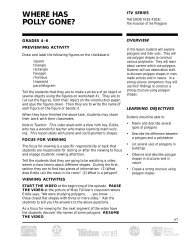Create successful ePaper yourself
Turn your PDF publications into a flip-book with our unique Google optimized e-Paper software.
idahoptv.org<br />
GENERAL MANAGER’S REPORT<br />
PAGE 26<br />
<strong>Idaho</strong> StoryCorps: One Woman’s Life With Polio<br />
By SAMANTHA WRIGHT<br />
<strong>June</strong> 26, <strong>2013</strong><br />
http://www.boisestatepublicradio.org/post/idaho‐storycorps‐onewomans‐life‐polio‐0<br />
Marilyn Shuler is perhaps best known for her work as the director of the<br />
<strong>Idaho</strong> Human Rights Commission from 1978 to 1998. She fought against<br />
the Aryan Nations and pushed for basic human rights in the Gem State.<br />
Credit StoryCorps<br />
Marcia Franklin and Marilyn Shuler talk about growing<br />
up with Polio in the 1950s.<br />
But what many people don’t know is that at the age of 10, Shuler was diagnosed with polio while she was living in<br />
Salem, Oregon. She sat down in the StoryCorps booth in Boise to talk about how it felt growing up in the 1950s<br />
with the illness.<br />
“What were your first symptoms?” asked Shuler’s friend Marcia Franklin, a producer and host at <strong>Idaho</strong> <strong>Public</strong><br />
<strong>Television</strong> since 1990.<br />
“Just feeling like I had the flu, and I just needed to go home and lie down,” said Marilyn Shuler. Before she was<br />
diagnosed, Shuler rode her bike and played outside in local parks, just like other children she knew.<br />
“How did it progress, what kind of symptoms happened after you had the flu feeling?” asked Franklin.<br />
“Well, I don’t remember being in great pain or anything I just remember I couldn’t move. There were certain<br />
muscles that didn’t work anymore,” explained Shuler.<br />
“So you never had to be in an iron lung?” asked Franklin, referring to the<br />
airtight metal tank that served as a breathing device for many polio<br />
patients.<br />
“No, I didn’t, but a lot of other children did,” said Shuler.<br />
Credit Just Us 3 / Flickr Creative Commons<br />
This is a 1950s‐era iron lung used to treat Polio<br />
patients.<br />
“What was the atmosphere in your community, in Salem, Oregon around<br />
that time?” asked Franklin. “Were a lot of people coming down with<br />
polio, were people in iron lungs, was there a sense of paranoia and fear?”<br />
“There was a real stigma having had polio, because of the fear,” said Shuler. “I became an immediate social isolate,<br />
because I don’t know whether it was my own friends or their parents, but I didn’t have any friends. I did try and go<br />
to school. I remember once falling down and the teacher didn’t even try and help me back up. I think they were<br />
afraid of us too, so it was just absolutely horrible.”<br />
“During the time of 5th, 6th, 7th grade, how were you able to get around, were you using crutches?” asked<br />
Franklin.











